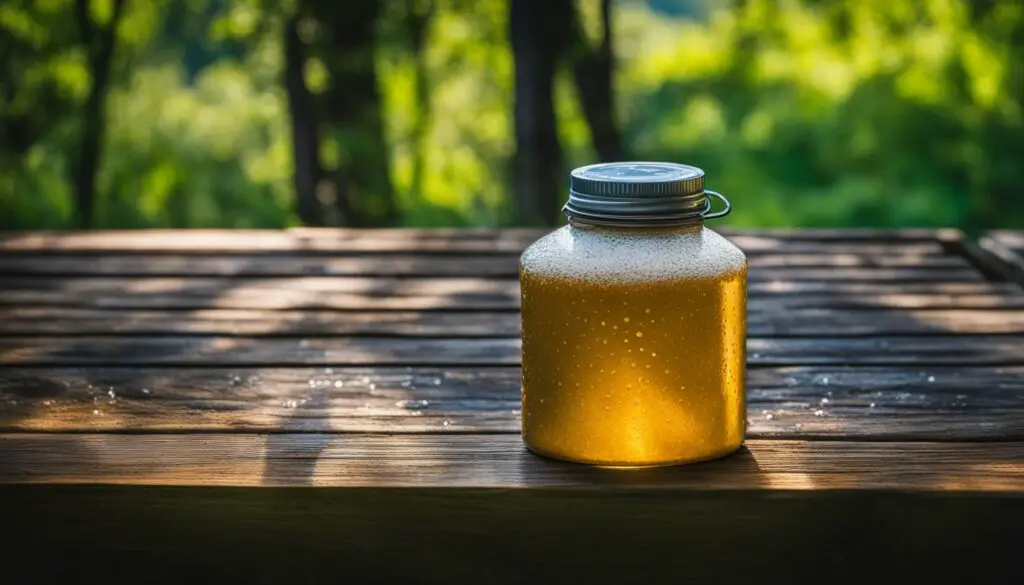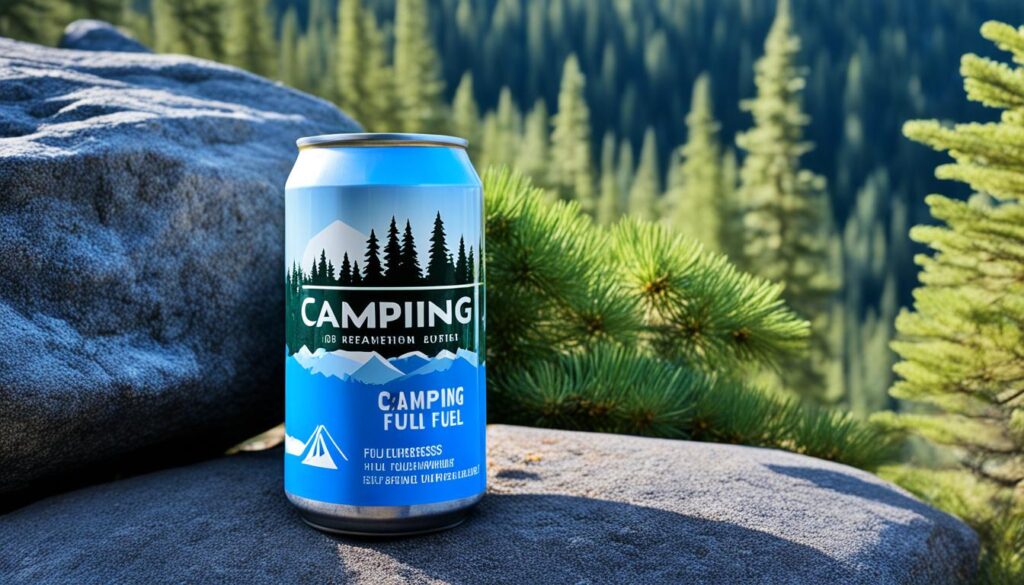How Long Does Camping Fuel Last
Outdoor lovers know how vital good camping fuel is. It powers our stoves, lanterns, and more. We’ll talk about different kinds of camping fuel, how long they last, and what affects their life.
Some like the easy use of liquid fuels, such as propane. Others choose the simplicity of solid fuels. We’ll discuss how to store your fuel and other important things. This will help you pick the right fuel for your needs.
Let’s talk about keeping your camping fuel ready for your next trip. With the right info, your fuel will last as long as you need it to.
Understanding Camping Fuel Types
Choosing the right camping fuel is key for your stove or lantern. You can pick from several types, each with its own benefits. Knowing about liquid, solid, and gas fuels helps you pick well, making your camping trip better.
Liquid Fuels: Propane, Butane, and White Gas
Liquid fuels are great for camp stoves and lanterns. Propane and butane mix to power easy-lighting stoves with good flame control. These stoves are cheap and light, staying potent for years if kept right. Yet, they might be hard to start in cold places or high up.
White gas, or Coleman fuel, is loved for its performance in the cold. Liquid-fuel stoves, needing to be primed, can work well up high too. White gas is easy to find, and these stoves might also run on kerosene or unleaded auto gas. But they are heavier and need more care than gas stoves.
Solid Fuels: Hexamine Tablets and Camping Fuel Cubes
If you want a neat, small fuel, try solid options like hexamine tablets or fuel cubes. These are mainly for campfires and cooking, offering a simple heat source. BioLite and others make stoves for these tablets or cubes. Be ready for a smell and wait if you use them for boiling water. Still, they are light and don’t need much upkeep, making them a favorite of light-packers.
Your best fuel choice depends on what you need and like, plus the weather and other outdoor factors. Knowing the, ups and downs helps you choose wisely. This way, your camp stove or lantern will serve you well on your trip.
Factors Affecting Camping Fuel Longevity
Several important things affect how long camping fuel lasts. Knowing these can keep your fuel fresh for your next trip. This means you’re always ready to hit the outdoors with no worries.
Storage Conditions: Temperature and Humidity
Where you keep your camping fuel is critical. Extreme temperatures, both hot and cold, aren’t good for it. To keep it in top shape, store your fuel somewhere cool and dry. Hot and cold swings can create moisture inside your fuel’s container. This moisture might mix with the fuel, making it less effective.
Container Quality and Sealing
The container you use is just as important. Top-notch, tightly sealed containers are a must. This keeps air away from the fuel, stopping it from going bad. Quality containers mean you can use your fuel for longer without any issues.
Knowing what keeps your camping fuel fresh is key. It’s all about where you store it, the temperature, the container’s quality, and how well it seals. By making smart choices, your fuel will stay good and reliable for your adventures.
How Long Does Camping Fuel Last?
The shelf life of camping fuel can change a lot. It depends on the type and how it’s stored. Knowing how long different camping fuels last is key to a good trip.
Liquid Fuels: Propane, Butane, and White Gas
Fuels like propane, butane, and white gas last long if kept right. Unopened cans can be good for years, usually 5 to 10. Once you open a container, use the fuel in a few months for the best quality and safety.
Solid Fuels: Hexamine Tablets and Camping Fuel Cubes
Hexamine tablets and fuel cubes don’t last as long as liquids. These solid fuels are good for about 6 months to a year. Be careful for signs of them going bad, as they can become less safe over time.
Storing your camping fuel well is very important. Things like temperature, moisture, and the container’s quality affect how long it lasts. Knowing this helps make sure your gear is ready for your next trip.
| Fuel Type | Typical Shelf Life |
|---|---|
| Propane | 5-10 years (unopened) 3-6 months (opened) |
| Butane | 5-10 years (unopened) 3-6 months (opened) |
| White Gas | 5-10 years (unopened) 2-4 months (opened) |
| Hexamine Tablets | 6 months to 1 year |
| Camping Fuel Cubes | 6 months to 1 year |
Remember, these are just general tips. Your fuel’s actual life can vary. Check your fuel’s condition before use, and get new supplies if it might be too old.

Signs of Expired or Deteriorated Camping Fuel
For those who love camping, keeping our gear top-notch is key. This is especially true for our camping fuel. Knowing when it’s expired or bad is vital for our safety during outdoor trips.
Visual Cues: Discoloration and Sediment
Expired camping fuel often changes color. While fresh fuel looks clear and clean, it might turn yellow or brown with time. If your stored fuel shows these colors, it’s probably gone bad.
Old camping fuel might also have sediment at the bottom. This can block your gear and even be dangerous. If you see discoloration or sediment, it’s time to get new fuel.
Performance Issues: Difficulty Igniting and Inconsistent Burn
If your stove or lantern struggles to light or the flame is uneven, the fuel might be bad. Fuel that doesn’t light well or burns oddly can be risky for your gear and safety.
Keep an eye out for these signs. They’ll help you make sure your camping fuel is good. This means your trips will be safer and more fun.
| Sign of Expired or Deteriorated Camping Fuel | Description |
|---|---|
| Discoloration | Fresh camping fuel should have a clear, clean appearance. Discoloration, such as a yellowish or brownish hue, can indicate the fuel has begun to break down. |
| Sediment | As camping fuel ages, it can form a layer of residue or debris at the bottom of the container. This sediment can clog fuel lines and affect the performance of your stove or lantern. |
| Difficulty Igniting | Expired or deteriorated camping fuel may not ignite as readily, compromising the overall functionality and safety of your outdoor equipment. |
| Inconsistent Burn | Deteriorated camping fuel may produce an unsteady, unreliable flame, further indicating the fuel has lost its potency. |
Proper Storage and Handling of Camping Fuel
Understanding how to store and handle camping fuel is key to making it last and keep you safe. The way you store and handle your fuel affects how well it works and how long it lasts.
Camping Fuel Storage Tips
It’s important to store camping fuel correctly. Follow these essential tips:
- Keep fuel in a cool, dry spot, away from the sun and heat.
- Make sure the container seals are good and closed tight to stop dirt getting in.
- Stand the containers up to avoid fuel going bad from big changes in temperature.
- It’s best to store fuel outside your home, like in a garage or shed.
Camping Fuel Handling Tips
Handling camping fuel the right way is crucial for safety and keeping the fuel good. Here’s what you should do:
- Always work with fuel in a place with lots of fresh air, far from fire or sparks.
- Be careful when you open and close fuel containers so you don’t spill.
- Never pour fuel right onto a fire or stove to prevent sudden dangerous flames.
- Get rid of any old or bad fuel the proper way, as the rules in your area say.
By sticking to these steps for storage and handling, you’ll make your camping fuel last longer and your outdoor trips safer and more fun.
Conclusion
The shelf life of camping fuel changes a lot, based on the type and how you store it. For example, liquid fuels such as propane, butane, and white gas last a long time. They can stay good for several years if you keep them right. But, solid fuels like hexamine tablets and camping fuel cubes might not last as long.
It’s important to know how to store your camping fuel and to check it often. Make sure your fuel containers are in good shape. This way, you can count on your camping fuel for your outdoor trips. This is true for short vacations or longer hikes. Just follow the correct storage and handling tips closely.
So, by learning about summary of camping fuel shelf life and keeping key takeaways on camping fuel longevity in mind, you can enjoy using your camping fuel for many years. Happy camping!
FAQ
What are the different types of camping fuels?
Camping fuels come in two main types. There are liquid fuels like propane, butane, and white gas. And there are solid fuels like hexamine tablets and camping fuel cubes.
How long does camping fuel typically last?
The shelf life of camping fuel varies. Liquid fuels last several years if stored right. Solid fuels have a shorter life, usually lasting from a few months to a year.
What factors affect the longevity of camping fuel?
The life of camping fuel is impacted by the storage. Temperature, humidity, and container quality are key.
How can I tell if my camping fuel has expired or deteriorated?
Look for signs of going bad. Things like color change or sediment. Also, watch out for lighting issues or an odd flame. These show it’s time for new fuel.
How should I properly store and handle camping fuel?
Store fuel in a cool, dry area, out of sunlight and heat. Make sure to keep the container sealed tight to avoid damage and keep the fuel fresh.
